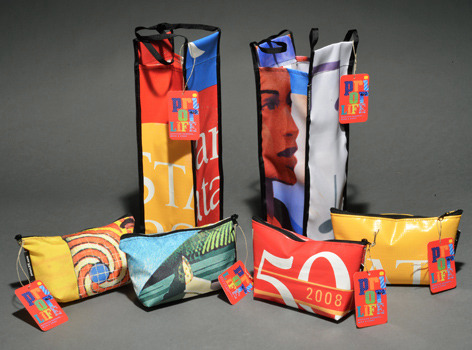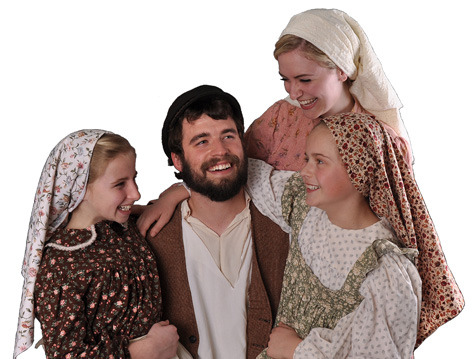More Iowa State banners recycled for new products

This year's recycled banner bags include a gift/wine bag and a zippered caddy/cosmetic bag. Photo by Bob Elbert.
They're colorful and practical. They promote Iowa State while tipping a hat to recycling. And each is one of a kind.
Cousins to the tote bag sold two springs ago, "banner bags" are back at the University Book Store in the Memorial Union. This year's models are a 9-inch zippered caddy/cosmetic bag and a 16-inch gift/wine bag with handles.
Over the winter, the office of University Marketing sent about 40 banners to priorLife in Traverse City, Mich., including 11 cloth banners that formerly hung in ISU Extension's Des Moines office and more than 30 vinyl banners that once were displayed on campus buildings or University Boulevard light poles. Remember some of these themes: ISU Sesquicentennial, multi-language "Welcome," National Special Olympics, Reiman Gardens, Cytennial homecoming, Eye on Cy? In some cases, the promotion or event ended; in others, sun, wind or rain took a toll on a banner.
priorLife converted the retired banners into about 450 unique bags. The zippered caddy/cosmetic bag sells for $14.99; the gift/wine bag retails for $19.99. Net proceeds from sales go back into the university banner program.
The bags will be sold in the bookstore through June. Any remaining bags will be available through the ISU Alumni Association's online shop.
CyBox: It's portable, secure and spacious
You might be a good candidate for CyBox, Iowa State's latest file storage and sharing system, if:
- You email work documents to yourself so that you can access them on the road or at home
- You share course-based materials with students
- You need to send a photo or video file that's too large to make it through Outlook Exchange
- You want to share files with people who aren't university employees or students
CyBox is Iowa State's version of the popular storage site Box.com. Unlike other storage sites, CyBox has beefed-up security features that meet federal requirements for protecting student privacy (Family Educational Rights and Privacy Act, FERPA).
More space for the asking
All faculty, staff and students get an automatic 25G of space under this free, cloud-based service. Faculty and staff allocations can be raised to 50GB at no additional charge.
CyBox can be accessed wherever you have a network and a computer or mobile device. Simply go to https://iastate.box.com and use your ISU Net-ID and password to sign in.
"You can use CyBox to share folders or files with others, on campus or off," said Mike Lohrbach, ITS senior systems analyst. "Sharing via CyBox, rather than email, reduces traffic and storage load on email servers," he said.
More accessories
CyBox also:
- Stores all the versions of a file, allowing you to access and revert to previous versions
- Syncs items with your desktop (download free application)
- Includes tools for embedding files into a website, taking notes and performing workflow tasks
More information about CyBox and other university storage options is available on the ITS file storage website.
Review of budget model wraps up
A five-member work group asked to assess 47 recommendations for the university's budget model advises that more than half (27) of them be implemented, and president Steven Leath has concurred.
Because they relate to setting academic priorities and policies, another 11 recommendations will be referred to senior vice president and provost Jonathan Wickert. The remaining nine will not be implemented now, but may get a second look after budget planning is completed for the year that begins July 1. Nearly all of the recommendations address either the budget planning process generally or the budget model (officially known as the Resource Management Model, or RMM) structure.
The work group's February implementation report (PDF) is online.
Leath highlighted the changes in a memo to Wickert and senior vice presidents Tom Hill (student affairs) and Warren Madden (business and finance) this week. Some of the 27 recommendations were implemented earlier this academic year, such as changes to budget advisory groups; the rest will be implemented in the next three months as part of the annual budget building process.
Some of the key items in those recommendations include:
- The formulas for distributing undergraduate and graduate/professional tuition dollars, respectively, among colleges and departments will remain unchanged.
- The portion of indirect cost revenue from external research grants that go to the principal researcher(s) will remain unchanged at 15 percent. (Proposed changes to the IDC formula weren't recommended for implementation.)
- The deferred maintenance fund must grow and reflect the size of the university's deferred maintenance backlog, currently about $262 million.
- Two central strategic funds – the Institutional Excellence Fund managed by the president and the Academic Excellence Fund managed by the provost – should be increased to levels that support university goals in academic programs, research, student enrollment, etc.
- A portion of the Institutional Excellence Fund will be earmarked to help campus service providers (for example, IT services, library, student services, facilities) handle unforeseen cost increases such as high enrollments.
- Formal and informal discussions need to occur early (fall) among senior leaders about setting university priorities that will guide the annual budget development process.
- Deans, administrators and their budget staff members need access to more helpful electronic data that improves and clarifies budget planning and management. Iowa State's investment in Kuali financial systems will help address this need.
The work group reviewed each of 47 recommendations in a May 2012 report (PDF) compiled by the committee that did a 10-month assessment of the then four-year-old budget model.
Did it work?
Work group member Dave Biedenbach, assistant vice president for financial planning and budgets in the president's office, noted that while the formal review of RMM is concluded, the changes implemented still are subject to scrutiny. Once the university FY14 budget is approved this summer, stakeholders will be asked whether the changes resulted in a more effective budget development process.
"We're still working out how we'll do it, but we're committed to having a mechanism in place at the end of the FY14 budget process that gives people input on how it's working," he said.
Joining Biedenbach on the work group were: Pam Elliott Cain, associate vice president for business and finance; Kathy Jones, associate vice president for student affairs; Miles Lackey, associate vice president and chief of staff in the president's office; and Ellen Rasmussen, associate vice president for academic planning and resources.
Spring is in the air

Nearly 50 students from the Agriculture Systems Technology Club changed oil, replaced spark plugs, cleaned air filters and sharpened blades on 185 push and riding lawn mowers during the club's annual lawn mower service days, April 5-6. The service is a fundraiser to help offset club expenses, primarily for field trips to agriculture companies and farm equipment shows. The club also holds a snow blower service day each fall. Photo by Bob Elbert.
Software copyright draft policy presented to council
Members of the Professional and Scientific Council learned more about a draft policy on software ownership and management at their April 4 meeting. University counsel Paul Tanaka and Nita Lovejoy, associate director in the office of intellectual property and technology transfer, presented information about the "Copyright Ownership and Management of Software Policy," which is in the comment period until April 19.
"Over the years, we've tried to do a more comprehensive copyright policy, and we run into obstacles along the way," Lovejoy said. "It came to our attention that software is getting treated differently across the institution, and ownership issues weren't real clear."
The policy, requested by Lovejoy's office, aims to provide guidance for ownership and management of software developed on campus. Faculty, staff and student software developers will be able to freely share the software they own -- for example, in teaching, research and open source agreements. University-owned software can be released back to the developer for non-commercial use, and royalties can be shared with developers when it is used commercially.
"We have a policy that says [the software] is going to be owned by the developer unless certain things apply -- there's an outside sponsored agreement; there's substantial use of university resources; there's collaborative work that is directed by the university in a team setting; it's administrative work; or it's extension work to be provided to the general public," Tanaka said.
"We're trying to set it up so it's as friction-free as possible for the distribution of software," he added.
Other business
- Nominations are being accepted for three executive committee positions: secretary; vice president for university planning and budget; and vice president for university community relations. The positions are one-year terms. Nominations will close and elections will be held at the May 2 meeting (2:13-4 p.m., MU Pioneer Room), nominees must be current council representatives or officers.
- Prior to his policy presentation, Tanaka addressed the recruiting violations the school self-reported to the NCAA last week. "We looked further and deeper than any known investigation into this telephone business, and we came up with ... a small amount of issues when you look at the scope, over all those calls and the number of coaches we have."
Stars Over Veishea stages timeless classic, 'Fiddler on the Roof'

Photo by Nancy Thompson.
There'll be no shortage of tradition when the music and theatre department and Stars Over Veishea, part of Iowa State's annual Veishea celebration since 1923, present Fiddler on the Roof April 12-21 in Fisher Theater.
Tevye, a poor dairyman from the Russian village of Anatevka, is the center of this enduring tale of love and laughter, devotion and defiance, traditions and change. As he struggles to preserve his family's traditions for future generations, Tevye's five daughters have other ideas. What unfolds is a comical and poignant story of how letting go of the past actually can make the future bright.
Some of Broadway's most beloved songs help tell this traditional tale, including Sunrise Sunset; Matchmaker, Matchmaker; and Tradition.
Principal actors include seniors Anson Woodin (Tevye) and Hannah Skalbeck (Golde, Tevye's wife). Tevye's daughters are played by freshmen Bethany Berger (Tzeitel), Grace Chermak (Hodel) and Kersten Tipping (Chava), and Ames fifth graders Josie Baum (Sprintze) and Sarah Carlson (Bielke).
The production is directed by Brad Dell, assistant professor of music and theatre; musically directed by Don Simonson, professor of music and theatre; and choreographed by Co'motion Dance Theatre's Valerie Williams.
You don't have to wait for Veishea to see Fiddler on the Roof. Show times are April 12, 13, 20 and 21 at 7:30 p.m., and April 14 and 21 at 2 p.m. Tickets are $21 ($16 for students) and available at the Iowa State Center ticket office or through Ticketmaster.
Students' fashion show is April 13

The dress on the center model (who's flanked by the students who designed it) captured first place awards in the wearable/experimental art and digital printing categories in the 2012 fashion show and ultimately claimed the "Best in Show" award. Submitted photo.
Iowa State's annual student-produced fashion show will be held April 13 (7 p.m., Stephens Auditorium). Tickets, including fees, are $27.75 ($21.60 for ISU students and youth 18 years and younger) and available online through Ticketmaster.
The guest judges this year were ISU alumni and fashion designers Brittany Craiger, Lea Leopold and Francesca Skwark, and New York model Haylynn Cohen. Judging occurred on March 30, when the team spent a full day assessing more than 200 garments. About 100 of those will appear in Saturday's show, either on a runway model or in an exhibition in the lobby.
One of the country's largest student-produced fashion shows, this year's event includes more than 100 students on the planning committee, 65 student models and 60 designers. The Fashion Show has been a juried event since 1982, but occurred for several decades before that.
